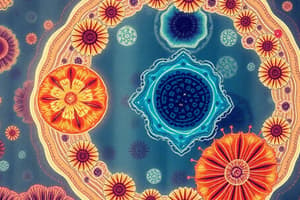Podcast
Questions and Answers
Which of the following scenarios would most likely result in a cell undergoing apoptosis due to the activity of the G2-M checkpoint?
Which of the following scenarios would most likely result in a cell undergoing apoptosis due to the activity of the G2-M checkpoint?
- A cell experiences a complete failure of DNA replication, leading to extensive DNA damage. (correct)
- A cell with a minor DNA replication error is exposed to a broad spectrum CKI medication.
- A cell successfully repairs a minor DNA error detected during the S phase.
- A cell experiences normal cyclin and CDK activity throughout the G2 phase.
How would the introduction of a drug that inhibits p53 affect cells with significant DNA damage?
How would the introduction of a drug that inhibits p53 affect cells with significant DNA damage?
- It would cause cells to undergo immediate and rapid apoptosis.
- It would cause cells to enter a state of permanent quiescence, like a neuron.
- It would enhance the DNA repair mechanisms, allowing the cell to recover.
- It would allow cells with damaged DNA to bypass checkpoints and continue dividing. (correct)
In a rapidly dividing cancer cell, what would be the most likely effect of a mutation that disables the cell's ability to degrade cyclins?
In a rapidly dividing cancer cell, what would be the most likely effect of a mutation that disables the cell's ability to degrade cyclins?
- The cell cycle would progress uncontrollably, bypassing normal regulatory checkpoints. (correct)
- The cell cycle would slow down, providing more time for DNA repair.
- The cell would undergo apoptosis due to the accumulation of cyclins.
- The cell cycle would pause indefinitely at all checkpoints, preventing further division.
A researcher discovers a novel protein that, when active, prevents the binding of cyclin-CDK complexes to their target proteins. Which phase of the cell cycle would this protein most likely disrupt?
A researcher discovers a novel protein that, when active, prevents the binding of cyclin-CDK complexes to their target proteins. Which phase of the cell cycle would this protein most likely disrupt?
A new drug is designed to specifically target and inhibit CDK4 and CDK6. What is the most likely intended outcome of this drug in cancer treatment?
A new drug is designed to specifically target and inhibit CDK4 and CDK6. What is the most likely intended outcome of this drug in cancer treatment?
Why are tissues with high cell turnover rates, such as the gastrointestinal tract and epidermis, more susceptible to cancer development?
Why are tissues with high cell turnover rates, such as the gastrointestinal tract and epidermis, more susceptible to cancer development?
How do cancer cells typically overcome the normal cell cycle checkpoints, allowing them to proliferate uncontrollably?
How do cancer cells typically overcome the normal cell cycle checkpoints, allowing them to proliferate uncontrollably?
A mutation inactivates the gene for p21, a CKI. How would this mutation affect the cell cycle in normal, healthy cells?
A mutation inactivates the gene for p21, a CKI. How would this mutation affect the cell cycle in normal, healthy cells?
In a tissue sample from a patient with an aggressive form of cancer, researchers observe unusually high levels of Cyclin D. What is the most likely implication of this finding?
In a tissue sample from a patient with an aggressive form of cancer, researchers observe unusually high levels of Cyclin D. What is the most likely implication of this finding?
Why is the development of drugs that target cell cycle checkpoints a promising but challenging approach in cancer therapy?
Why is the development of drugs that target cell cycle checkpoints a promising but challenging approach in cancer therapy?
Flashcards
Cell Cycle
Cell Cycle
Succession of events happening in a specific order to assure cell proliferation.
G0 Phase
G0 Phase
Cells that are not actively cycling; quiescent cells.
Permanent Cells
Permanent Cells
Permanent cells that have lost the capacity to proliferate and are forever in G0.
Labile Cells
Labile Cells
Signup and view all the flashcards
Checkpoints (G1-S, G2-M)
Checkpoints (G1-S, G2-M)
Signup and view all the flashcards
Cyclins
Cyclins
Signup and view all the flashcards
Cyclin-Dependent Kinases (CDKs)
Cyclin-Dependent Kinases (CDKs)
Signup and view all the flashcards
G1-S Checkpoint
G1-S Checkpoint
Signup and view all the flashcards
G2-M Checkpoint
G2-M Checkpoint
Signup and view all the flashcards
Cyclin-Dependent Kinase Inhibitors (CKIs)
Cyclin-Dependent Kinase Inhibitors (CKIs)
Signup and view all the flashcards
Study Notes
- The cell cycle is a series of events that leads to cell proliferation
- It is fundamental for organism development and maintaining tissue homeostasis.
- Tissue homeostasis replaces dead or damaged cells.
- Stem cells are important in tissue homeostasis because of their regenerative capabilities.
- Accurate DNA replication is crucial for cell division.
Cell Cycle Phases
- G0 (Quiescence): Cells are not actively cycling
- G1 (Gap 1): Cell grows and prepares for DNA synthesis.
- S (Synthesis): DNA is replicated.
- G2 (Gap 2): Cell prepares for mitosis.
- M (Mitosis): Cell divides into two daughter cells.
- Neurons and cardiac myocytes are permanent cells in G0 that cannot proliferate
- Hepatocytes are stable cells in G0 that can re-enter the cell cycle.
- Gastrointestinal and skin cells are labile tissues with high turnover rates and frequent division.
Cell Cycle Checkpoints
- G1-S checkpoint monitors DNA integrity before DNA replication starts
- G2-M checkpoint confirms DNA replication completed accurately before mitosis.
- Checkpoints prevent cells with damaged or unduplicated DNA from progressing through the cell cycle.
- Cancer cells evade checkpoints, leading to uncontrolled proliferation.
Regulation of Cell Cycle
- Activators and inhibitors regulate the cell cycle.
- Cyclins bind to cyclin-dependent kinases (CDKs), forming cyclin-CDK complexes.
- Cyclin-CDK complexes phosphorylate substrates and promote cell cycle progression.
- Cyclins A, B, D, and E are the most important.
- Cyclin synthesis increases during cell cycle stages, activating CDK complexes.
- After cell cycle completion, cyclins degrade, and CDK activity decreases.
G1 to S Phase Transition
- At the G1-S transition, the G1 restriction point ensures DNA integrity.
- Retinoblastoma protein (Rb) phosphorylation is regulated by Cyclin D-CDK4/6 and Cyclin A-CDK2 complexes.
S Phase to G2-M Transition
- During the S phase DNA is replicated
- The G2-M restriction point confirms DNA replication is complete before mitosis.
- Cyclin B-CDK1 complexes regulate the G2-M checkpoint.
- DNA defects trigger DNA repair mechanisms or division delay.
- Severe DNA damage induces senescence (permanent growth arrest) or apoptosis (programmed cell death).
Inhibitors of Cell Cycle
- Cyclin-dependent kinase inhibitors (CKIs) act on cyclin-CDK complexes.
- Broad-spectrum inhibitors include p21, p27, and p57.
- Specific inhibitors include p15, p16, p18, and p19, which act on CDK4 and CDK6.
- Understanding molecular mechanisms of the cell cycle is crucial for developing cancer therapies.
Studying That Suits You
Use AI to generate personalized quizzes and flashcards to suit your learning preferences.



